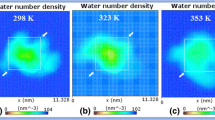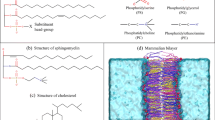Abstract
We have investigated the effect of ionic strength on the aggregation behavior of n-dodecyl phosphocholine. On the basis of the classical Corrin–Harkins relation, the critical micellar concentration of this detergent decreases with a biphasic trend on lithium chloride addition. It is nearly constant below 150 mM salt, with a mean value of 0.91 mM, whereas it undergoes a dramatic 80-fold decrease in 7 M LiCl. Such a drop in the critical micellar concentration could be explained by the effect of salting out and the implication of phosphocholine head groups on the organization of surrounding water. Knowledge of the effective critical micellar concentration of n-dodecyl phosphocholine could be useful in the purification of membrane proteins in non-denaturing conditions.



Similar content being viewed by others
References
Corrin ML, Harkins WD (1947) The effect of salts on the critical concentration for the formation of micelles in colloidal electrolytes. J Am Chem Soc 69:683–688
Schick MJ (1964) Effect of electrolyte and urea on micelle formation. J Phys Chem 68:3585–3592
Emerson MF, Holtzer A (1965) On the ionic strength dependence of micelle number. J Phys Chem 69:3718–3721
Kresheck GC (1975) Surfactants. In: Franks F (ed) Water: a comprehensive treatise, vol. IV. Plenum, New York, pp 95–167
Chattopadhyay A, Harikumar KG (1996) Dependence of critical micelle concentration of a zwitterionic detergent on ionic strength: implications in receptor solubilization. FEBS Lett 391:199–202
Yaseen M, Wang Y, Su TJ, Lu JR (2005) Surface adsorption of zwitterionic surfactants: n-alkyl phosphocholines characterised by surface tensiometry and neutron reflection. J Colloid Interface Sci 288:361–370
Tanford C, Reynolds JA (1976) Characterization of membrane proteins in detergent solutions. Biochim Biophys Acta 457:133–170
Lauterwein J, Bosch C, Brown L, Wuthrich K (1979) Physicochemical studies of the protein-lipid interactions in melittin-containing micelles. Biochim Biophys Acta 556:244–264
Vinogradova O, Sönnichsen F, Sanders CR (1998) On choosing a detergent for solution NMR studies of membrane proteins. J Biomol NMR 11:381–386
Arora A, Tamm LK (2001) Biophysical approaches to membrane protein structure determination. Curr Opin Struct Biol 11:540–547
Baleja JD (2001) Structure determination of membrane-associated proteins from nuclear magnetic resonance data. Anal Biochem 288:1–15
Choowongkomon K, Carlin CR, Sonnichsen FD (2005) A structural model for the membrane-bound form of the juxtamembrane domain of the epidermal growth factor receptor. J Biol Chem 280:24043–24052
Oxenoid K, Chou JJ (2005) The structure of phospholamban pentamer reveals a channel-like architecture in membranes. Proc Natl Acad Sci USA 102:10870–10875
Caillet-Saguy C, Piccioli M, Turano P, Izadi-Pruneyre N, Delepierre M, Bertini I, Lecroisey A (2009) Mapping the interaction between the hemophore HasA and Its outer membrane receptor HasR using CRINEPT—TROSY NMR spectroscopy. J Am Chem Soc 131:1736–1744
Gorzelle BM, Nagy JK, Oxenoid K, Lonzer WL, Cafiso DS, Sanders CR (1999) Reconstitutive refolding of diacylglycerol kinase, an integral membrane protein. Biochemistry 38:16373–16382
Slavík J (1982) Anilinonaphthalene sulfonate as a probe of membrane composition and function. Biochim Biophys Acta 694:1–25
DeVendittis E, Palumbo G, Parlato G, Bocchini V (1981) A fluorimetric method for the estimation of the critical micelle concentration of surfactants. Anal Biochem 115:278–286
Esposito C, Colicchio P, Facchiano A, Ragone R (1998) Effect of a weak electrolyte on the critical micellar concentration of sodium dodecyl sulfate. J Colloid Interface Sci 200:310–312
Cantor CR, Schimmel PR (1980) Biophysical Chemistry, part II. Freeman, New York
Kallick DA, Tessmer MR, Watts CR, Li CY (1995) The use of dodecylphosphocholine micelles in solution NMR. J Magn Reson B 109:60–65
Van Dam-Mieras MCE, Slotboom AJ, Pieterson WA, De Haas GH (1975) Interaction of phospholipase A2 with micellar interfaces. Role of the N-terminal region. Biochemistry 14:5387–5394
Stafford RE, Fanni T, Dennis EA (1989) Interfacial properties and critical micelle concentration of lysophospholipids. Biochemistry 28:5113–5120
Nakagaki M, Komatsu H, Handa T (1986) Estimation of critical micelle concentrations of lysolecithins with fluorescent probes. Chem Pharm Bull 34:4479–4485
Lazaridis T, Mallik B, Chen Y (2005) Implicit solvent simulations of DPC micelle formation. J Phys Chem B 109:15098–15106
Macdonald PM, Rydall JR, Kuebler SC, Winnik FM (1991) Synthesis and characterization of a homologous series of zwitterionic surfactants based on phosphocholine. Langmuir 7:2602–2606
Kaufmann TC, Engel A, Rèmigy H-W (2006) A novel method for detergent concentration determination. Biophys J 90:310–317
Anatrace, Inc. (2007–2008) Catalog. Maumee, OH 43537, p 60
GE Healthcare (2007) Purifying challenging proteins: principles and methods. Uppsala, Sweden, p 22
Ray A, Nemethy G (1971) Effects of ionic protein denaturants on micelle formation by nonionic detergents. J Am Chem Soc 93:6787–6793
Mukerjee P, Chan CC (2002) Effects of high salt concentrations on the micellization of octyl glucoside: salting-out of monomers and electrolyte effects on the micelle-water interfacial tension. Langmuir 18:5375–5381
Martinez-Landeira P, Ruso JM, Prieto G, Sarmiento F (2002) Surface tensions, critical micelle concentrations, and standard free energies of micellization of C8-lecithin at different pHs and electrolyte concentrations. J Chem Eng Data 47:1017–1021
Tausk RJM, Karmiggelt J, Oudshoorn C, Overbeek JTG (1974) Physical chemical studies of short-chain lecithin homologues. I.: influence of the chain length of the fatty acid ester and of electrolytes on the critical micelle concentration. Biophys Chem 1:175–183
King MD, Marsh D (1987) Head group and chain length dependence of phospholipid self-assembly studied by spin-label electron spin resonance. Biochemistry 26:1224–1231
Mukerjee P (1965) Salt effects on nonionic association colloids. J Phys Chem 69:4038–4040
Koszlelak-Rosenblum M, Krol A, Mozumdar N, Wunsch K, Ferrin A, Cook E, Veatch CK, Nagel R, Luft JR, DeTitta GT, Malkowski MG (2009) Determination and application of empirically derived detergent phase boundaries to effectively crystallize membrane proteins. Protein Sci. doi:10-1002/pro.193
Eshaghi S, Hedrén M, Nasser MI, Hammarberg T, Thornell A, Nordlund P (2005) An efficient strategy for high-throughput expression screening of recombinant integral membrane proteins. Protein Sci 14:676–683
White MA, Clark KM, Grayhack EJ, Dumont ME (2007) Characteristics affecting expression and solubilization of yeast membrane proteins. J Mol Biol 365:621–636
Newstead S, Kim H, von Heijne G, Iwata S, Drew D (2007) High-throughput fluorescent-based optimization of eukaryotic membrane protein overexpression and purification in Saccharomyces cerevisiae. Proc Natl Acad Sci USA 104:13936–13941
Gutmann DAP, Mizohata E, Newstead S, Ferrandon S, Henderson PJF, Van Veen HW, Byrne B (2007) A high-throughput method for membrane protein solubility screening: the ultracentrifugation dispersity sedimentation assay. Protein Sci 16:1422–1428
Geertsma ER, Groeneveld M, Slotboom D-J, Poolman B (2008) Quality control of overexpressed membrane proteins. Proc Natl Acad Sci USA 105:5722–5727
Rivnay B, Metzger H (1982) Reconstitution of the receptor for immunoglobulin E into liposomes. Conditions for incorporation of the receptor into vesicles. J Biol Chem 257:12800–12808
Hjelmeland LM, Chrambach A (1984) In: Venter JC, Harrison LC (eds) Membranes, detergents, and receptor solubilization. A.R. Liss, New York, p 35
Schürholz T (1996) Critical dependence of the solubilization of lipid vesicles by the detergent CHAPS on the lipid composition. Functional reconstitution of the nicotinic acetylcholine receptor into preformed vesicles above the critical micellization concentration. Biophys Chem 58:87–96
Author information
Authors and Affiliations
Corresponding author
Rights and permissions
About this article
Cite this article
Palladino, P., Rossi, F. & Ragone, R. Effective Critical Micellar Concentration of a Zwitterionic Detergent: A Fluorimetric Study on n-Dodecyl Phosphocholine. J Fluoresc 20, 191–196 (2010). https://doi.org/10.1007/s10895-009-0537-0
Received:
Accepted:
Published:
Issue Date:
DOI: https://doi.org/10.1007/s10895-009-0537-0




